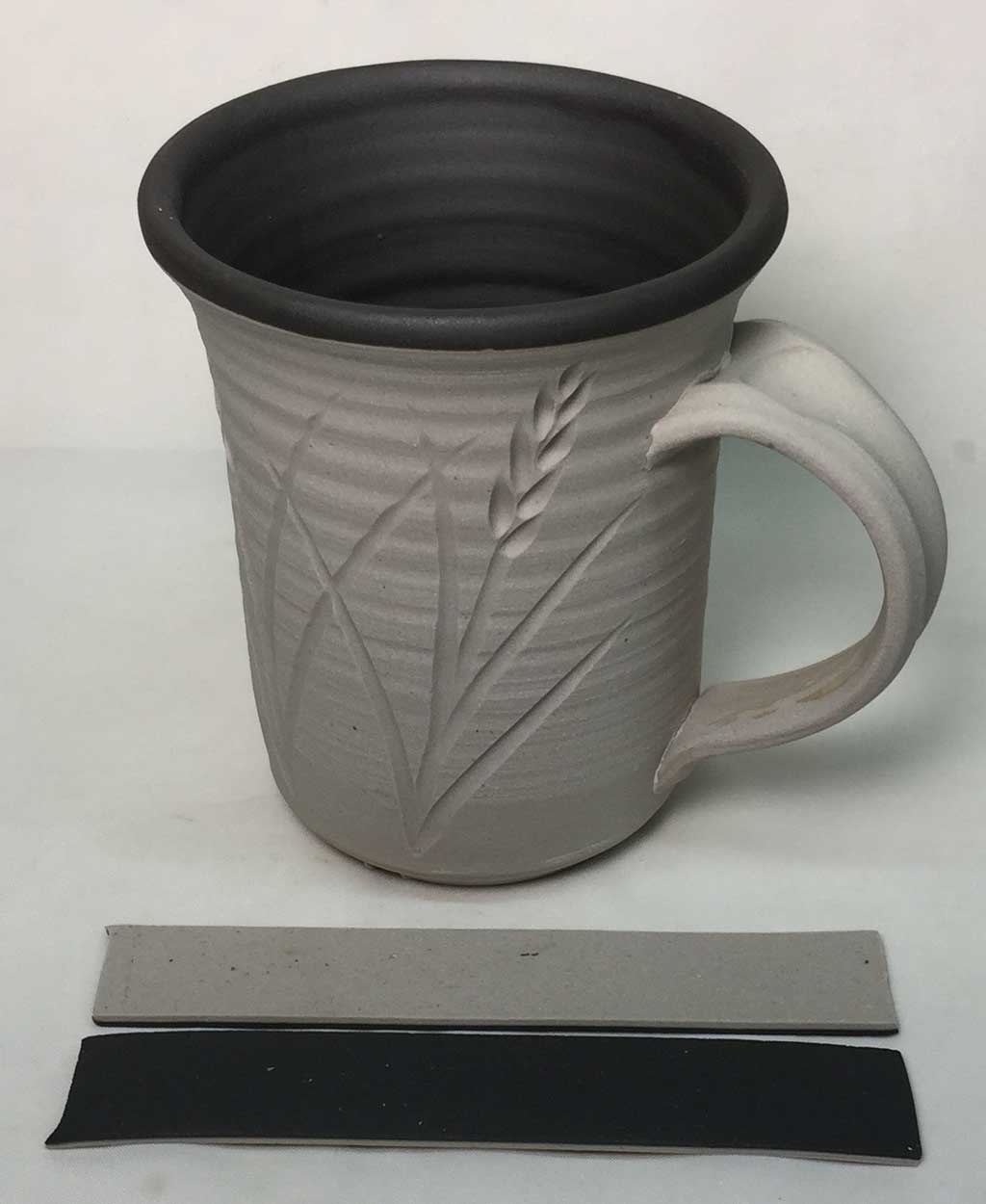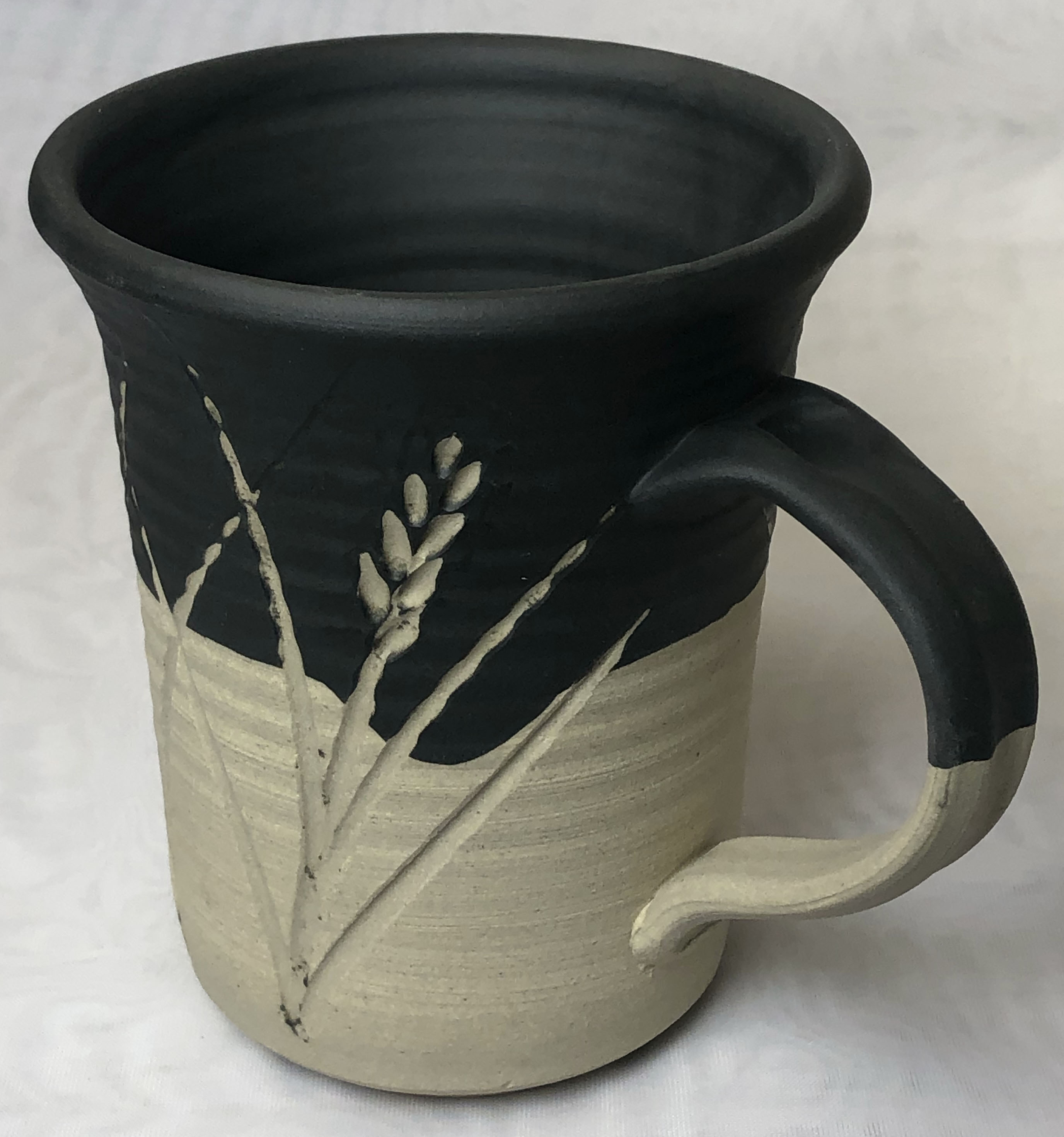| Monthly Tech-Tip | No tracking! No ads! | |
Absolutely Jet-Black Cone 6 Engobe on M340
This could also be super white
This is the L3954B engobe. 15% Mason 6600 black body stain has been added (instead of the normal 10% Zircopax used for white). Of course, a cover glaze is needed for a functional surface. We put a lot of development work into producing a recipe fits this body, M340. It works even when thickly applied because it has the same fired maturity as the body. Lots of information is available on using L3954B (including mixing and adjustment instructions). Engobes are tricky to use, follow the links below to learn more. L3954B is designed to work on regular Plainsman M340 (this piece), M390 and Coffee Clay. Most important we document how to adjust its maturity, and thus firing shrinkage, to fine tune fit if needed. These bodies dry better than porcelains and are much less expensive, so coating them with an engobe to get a surface like this makes a lot of sense. Ed Phillipson discovered this 80 years ago, enabling selling pieces made from these clays as white hotel ware.
Related Pictures
How to test if an engobe fits a clay body

This picture has its own page with more detail, click here to see it.
This is part of a project to fit an engobe (slip) onto a terra cotta at cone 02 using the EBCT test.
Left: On drying the red body curls the bi-clay strip toward itself, but on firing it goes the other way!
Right: SHAB test bars of the white slip and red body enable comparing their drying and firing shrinkages.
Center back: A mug with the white engobe and a transparent overglaze. The slip is going translucent under the glaze because it is too vitreous. Its higher fired shrinkage curls the bi-clay bars toward itself. Reducing the frit will reduce the firing shrinkage and make it more opaque (because it will melt less).
Front: A different, more vitreous red body (Zero3 stoneware) fits the slip better (the strips dry and fire straight).
Here is why porcelain engobe does not fit stoneware

This picture has its own page with more detail, click here to see it.
This is how bad the fit can actually be. In the front is a bi-clay EBCT test strip of a grogged cone 10R sculpture clay sandwiched with a porcelain. After drying this bar was relatively straight. The back bar bent quite a bit even after bisque. But the bend on the front bar really shows the misfit. But this is not a thermal expansion issue where volume changes are measured in 100ths of a mm - these plastic bodies shrink 5-8% during firing, that is up to 8mm change in these 10cm long cars, that is the kind of volume change needed to make this happen. The porcelain has the higher fired shrinkage so it pulls the bar toward itself. The internal stress makes this bar a time bomb, waiting for a mechanical or thermal trigger to burst it into a hundred pieces. Admittedly, putting a thin layer of this porcelain onto a piece of heavy ware is not going to bend it - but the stresses of the porcelain being stretched-bonded will still be there, seeking relief (likely exhibited by cracking or flaking).
Stained engobes can be applied thinly yet fire opaque

This picture has its own page with more detail, click here to see it.
This black engobe, L3954F, is on a cone 6 buff stoneware (at leather hard stage). It contains only 7.5% Mason 6600 black stain. How is that possible? Why do people add so much more to their underglazes? Because this recipe has been tuned to have the same degree of maturity as the body - it therefore fires totally opaque. This contrasts with underglaze/engobe recipes containing significant frit, among other issues, their vitreous nature renders them translucent. Thus, up to 40% stain is needed to crowbar their opacity enough to intensify color. And a thicker application (that carries other issues).
Notice how thinly and evenly this is applied. This was possible because of another key factor: The slurry was adjusted to be thixotropic. The thinner layer enables drying more quickly. The body-compatible engobe recipe also means fewer issues with flaking during drying, better fire-fit.
How to make a black cone 6 oxidation clay body

This picture has its own page with more detail, click here to see it.
Many cone 6 black clay bodies are available commercially. Some manufacturers are using manganese dioxide but the fume hazards seem far too serious to risk. Is it practical to slurry up your own from a recipe? Yes. Probably the most common method is the addition of raw umber or burnt umber. Umber behaves as a flux so when added to middle temperature bodies the resulting clay becomes too vitreous (so warping, bloating and glaze blisters are common). The secret is too add the umber to a cone 10 stoneware and the umber fluxes it to a cone 6 stoneware. Another method is the use of a black stain. Stains carry no danger of bloating and they work really well. However, the elephant in the room here is cost (that’s also why cobalt is not even on the table). But there is a way to make black stain affordable: Using a jet-black engobe.
All these bars were fired to cone 6 (although they are numbered 5).
Top bar: L4768D, a white cone 10R porcelain with 10% umber (the result is too vitreous and colour has gone brown).
L4768E is a cone 10 red burning stoneware stained with 5% umber. The red fireclay in its recipe is the secret of it being sufficiently refractory to host the umber.
L4484D is MNP plus 6% Mason 6666 black stain. Normally more stain would be needed if it were a white burning porcelain.
P6729 and P7159 are both Plainsman Coffee clay, it is made using 10% burnt umber.
L3954J black engobe on a cone 10R whiteware body

This picture has its own page with more detail, click here to see it.
The body is Plainsman H570 (0.5-1% porosity). This piece is not glazed. The firing schedule is C10RPL. Notice the EBCT test bars in front (engobe compatibility). These sandwich the body and the L3954J engobe together in a thin strip, differences in fired shrinkage curl the bar during firing (toward the one of higher shrinkage). The straighter the bars fire the better the fit. My regular engobe for use on our buff stoneware, L3954N (Plainsman H550, 2-3% porosity), has lower fired shrinkage than this (since that body is less vitreous). This one increases that shrinkage (with 5% more nepheline syenite, 5% less silica and 3% less ball clay). This employs 10% Mason 6600 stain to produce the jet-black fired product. 6600 is their cobalt black stain but the 6666 cobalt-free one should also work, both are suitable as body stains and recommended to 2300F (1260C) - cone 10 is technically above this limit but we have not encountered issues.
Videos
Links
| Recipes |
L3954B - Cone 6 Engobe (for M340)
Dry and firing shrinkage fitted to Plainsman M390, M340 |
| URLs |
https://plainsmanclays.com/l3954b
The L3954B engobe page at PlainsmanClays.com explains how to mix and use it on Plainsman clays bodies at cone 6. |
| Materials |
Mason 6600 Black Stain
A cobalt-containing stain useful in bodies, engobes and glazes at a wide range of temperatures. |
| Glossary |
Thixotropy
Thixotropy is a property of ceramic slurries of high water content. Thixotropic suspensions flow when moving but gel after sitting (for a few moments more depending on application). This phenomenon is helpful in getting even, drip-free glaze coverage. |
| Glossary |
Engobe
Engobes are high-clay slurries that are applied to leather hard or dry ceramics. They fire opaque and are used for functional or decorative purposes. They are formulated to match the firing shrinkage and thermal expansion of the body. |
Got a Question?
Buy me a coffee and we can talk

https://digitalfire.com, All Rights Reserved
Privacy Policy

